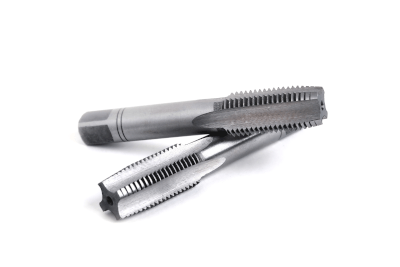What Is a Hand Tap (Bit)?
 A hand tap (bit) is a tool used to form female threads for screwing in various bolts by cutting.
A hand tap (bit) is a tool used to form female threads for screwing in various bolts by cutting.
It is used to make a hole drilled as a pre-drilled hole, and threads are formed by manual cutting. A hand tap comes in sets of three and is used in order from No. 1 to No. 3 to finish the threads.
There are various types of hand taps. Typical types include point taps, spiral taps, hand taps, and pipe taps.
In the case of these types of taps, the thread shape is formed by cutting by screwing the various types of taps into a pre-processed hole. There are two types of pre-holes: through holes and stop holes. The tap to be used may differ depending on the pre-processed hole to be machined.
Uses of Hand Taps
Hand taps are widely used in metalworking. Screws are often used to fasten a metal part to another part. In such cases, hand taps are used to form the female threads that tighten the screws.
Hand taps are basically used by hand, but that does not mean that they cannot be used for machining. However, hand taps are not suitable for mass production or automated machining because they cannot discharge chips and hold them in.
Principles of Hand Taps
There are three types of hand taps for manually cutting threaded holes: No. 1, No. 2, and No. 3, depending on whether they are used in the first, middle, or top position, or in what they are called. They are used in the following order to form a female thread.
1. First (No. 1) Tap
The No. 1 tap is the first tap to be used on a pre-drilled hole. The tip is thin and the cutting edge of the tip, which is the part that bites into the hole, is cut to 9 teeth.
2. Medium (No. 2) Tap
The medium (No. 2) tap is mainly used to feed the threads machined by the preceding tap. For this reason, the tapered shape is used for the first 5 threads from the tip.
3. Raise (No. 3) Tap
Raise (No. 3) taps have only 1.5 threads on the cutting edge of the tip. Even a stop hole can be machined deep into the hole, which is not possible with the tip and middle taps.
The tap is designed to machine one pitch of a screw per revolution. First, the tip of the first (No. 1) tap bites into the hole, and the tap follows the tip of the first tap. Usually, the tap is turned only one revolution and then turned back one-quarter of a turn, so that the tap does not cut all the way through the hole at once.
Other Information on Hand Taps
1. How to Use a Hand Tap
Hand taps are manual operation, so it is important to tap straight into the hole. When biting the tip of the first (No. 1) tap, care must be taken to ensure that the tap is not at an angle, as a bent tap tip will follow the threads of the tap.
In the order of the tap number, follow the depth of the cut of the tap, and process the tap without forcing it. Also, apply cutting oil when machining. Cutting oil reduces the frictional resistance of the tap and enhances the evacuation of chips, allowing for smoother cutting.
2. Hand Tap Handles
This tool allows manual drilling of threaded holes by attaching a handle to a tap drill. It is turned and processed little by little while using tapping oil.
The hand tap’s handle must be selected to match the size of the tap. Use of an incorrectly sized handle may cause the tap to spin and break.
3. Spiral Tap
A spiral tap has a spiral (twisted) groove, and chips are discharged along the groove. Since chips are discharged to the outside and do not accumulate in the tapped hole, spiral taps are used for the tapping of stop holes.
Since it is used for machining stop holes, it is necessary to machine to a specific position and is not often used manually. For manual machining, the No. 1 or No. 2 hand taps are used.